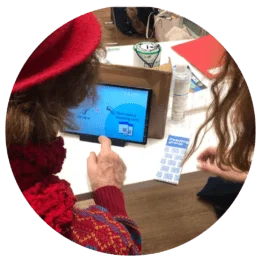Overview
Aims
- Test and learn about the most effective way to run an online community group using the Digital Befriending Kit
- Evaluate the usability of the kit and the process of running the group sessions
Process
Recruitment
We aimed for 12 participants (people living with dementia) to take part in a four-week pilot of online community groups. We achieved 11 participants as a promising lead declined to consent and stopped responding to our calls.
Once we started getting consent from the 11 participants and installing the equipment, it was necessary to start the group sessions promptly so that the participants would not forget how to use the kit, misplace anything or have to join the pilot two or three sessions in. This led to an effective cut-off date for recruitment so we did not try to fill the 12th place once the first session had taken place.
We recruited participants through community groups with whom relationships had been developed during the co-design phase and split them into two groups (one in West London and the other in South East London).
Participants were accompanied by carers throughout the process and, following consultation with community group leads known to them, were judged to have adequate capacity to consent.
Consent
Consent forms were completed by participants with the help of a carer (relative) at an in-person community group or by post with the help of community group leads.
Installation visits
Members of the project team who are DBS checked and have experience interacting with people living with dementia visited the homes of pilot participants to install the kit. One of the participants did not have a Wi-Fi connection so we also installed a Wi-Fi router for them.
During the installation visit, the team provided training in how to use the kit. This involved demonstrating joining a call using the Zoom Ticket and then getting the participant to try joining a call two or three times in order to help them build confidence.
We gave each participant two Zoom Tickets – one for a weekly group call and one for individual calls with team members for evaluation sessions.
The installation process included:
- Testing the internet speed (at least 5 Mbps is recommended for a successful Zoom call)
- If there was no Wi-Fi connection or a slow internet speed, installing a Wi-Fi router with SIM card
- Demonstrating joining a call and asking the participant to practise at least twice during the visit
- If possible, leaving the stand and iPad set up and plugged into the power
- Storing Zoom Tickets in the back of the tablet stand in the correct position for use
- Leaving a telephone number with the participant and carer that could be used for troubleshooting if something went wrong with the kit
Online community groups
We ran online community group sessions of one hour once a week for four weeks. Each week, there was a different activity, including poetry, music, bingo and drawing. The activity was approximately 30 minutes in length preceded and followed by open, semi-guided conversation. We have included some tips for running online community groups below.
Before the session
- Develop an online community group script to help guide the sessions
- Participants, particularly those who are more isolated, may need to be reminded about the session by telephone a day before and again on the day (30 minutes to 10 minutes before the start time)
- Telling participants what to expect in the session helps to ensure they feel comfortable and gives them the option not to participate if there is going to be an activity they might not enjoy
During the session
- Discuss some guidelines with the group at the start of the first session (e.g. about being free to leave at any time and raising their hand to alert the facilitator)
- Ask for feedback from participants (e.g. can they hear well?)
- Five participants is a comfortable number for an online community group – this is sufficient to have a good discussion without being overwhelming for participants or resulting in people talking over each other or disengaging from the process
- Two facilitators should run the session (one who is focused on engaging the participants and another in a technical support role)
- Ask every participant to introduce themselves at the beginning of the session so they feel acknowledged, welcome and encouraged to contribute
- We asked participants to keep their microphones on (unmuted) to encourage spontaneous conversation and interactions and, on the whole, this worked well – occasionally, it was necessary to mute a participant to prevent background noise disturbing the meeting but we could then use the Zoom ‘Ask to unmute’ function
- When a team member was taking notes during the session, we found that turning off their camera after introducing themselves reduced distractions
- Facilitators can try to encourage conversation between participants and ensure that everyone gets to speak to the extent they feel comfortable with
- Ask for feedback from participants at the end of the session (e.g. Did they enjoy it? What activity would they like to do next time?)
After the session
- Check in with participants after the session to understand what they enjoyed and did not enjoy and to see if there is any troubleshooting of the kit that can be done ahead of the next session
1:1 phone/Zoom check-ins
We contacted each participant once a week by telephone or using the Digital Befriending Kit to understand their experience of using the kit and attending the online groups (usability and enjoyment), check they were happy to continue with the pilot and remind them of the next group session.
Outputs
- Eight online community groups, each lasting an hour (two groups x four sessions)
- Quantitative data from pre and post pilot questionnaires about digital confidence and loneliness
- Qualitative data from 1:1 check-ins about usability and enjoyment of the kit and group sessions
Resources

